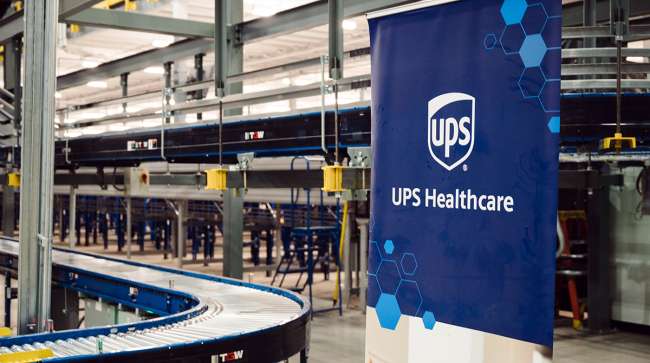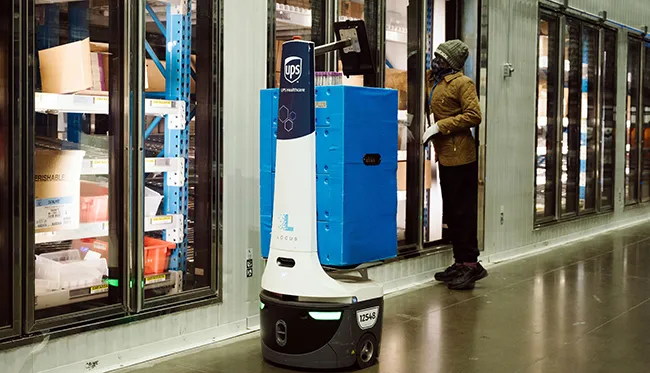Bloomberg News
Health Care Business Becomes $20 Billion Lifeline for UPS

[Stay on top of transportation news: Get TTNews in your inbox.]
UPS Inc. has been quietly building a health care empire to offset stagnating revenue in its core package delivery business.
Specialized logistics services, unlike standard brown-box delivery, have appealing profit margins. A customer who needs injectable medicines shipped overnight in a refrigerated box is willing to pay a hefty premium.
“You’re maybe getting $300 on that shipment at the same cost of delivering, say, a J. Crew box of socks,” said Anthony de Ruijter, an analyst at Third Bridge, a global research firm.
UPS Healthcare was a $10 billion business at the end of 2023, accounting for about one-tenth of total revenue. The company aims to double that number by 2026 with the help of acquisitions and new business ventures.
UPS ranks No. 1 on the Transport Topics Top 100 list of the largest for-hire carriers in North America. UPS Supply Chain Solutions is No. 4 on the TT Top 100 logistics companies list.
For its latest endeavor, UPS is renting out about 100,000 square feet of custom laboratory space near its main air cargo hub in Louisville. Construction was completed at the end of the year, and medical companies have already locked up all the available space for the next 10-plus years. By setting up shop directly on UPS property, they’ll be able to process test results within a matter of hours. The facility, known as Labport, will soon be bustling with technicians preparing samples, scientists peering under microscopes, and computers churning out data to treat faraway patients.
That doesn’t sound like a parcel company. In fact, the business is so unusual that it’s ditching the trademark brown that has made UPS delivery drivers, trucks and cargo planes recognizable around the world for the last century. UPS Healthcare employees will wear navy blue instead.
“We’re not going to stay in our box,” said John Bolla, president of UPS Healthcare. “We can do something different, and we can do something to deliver faster for patients.”
Health care is a panacea of sorts for the broader UPS brand, whose core business is growing less profitable by the day. Cash-strapped Americans have been shunning next-day delivery in favor of less lucrative ground shipping, and higher-margin business-to-business deliveries have dropped off. Premium services are a way to stem the bleeding. UPS has said the operating margin for its health care business is in the high teens, compared with 10% for the overall business in 2023.

A worker uses a Locus robot designed to assist with packages and automation. (Scotty Perry/Bloomberg)
“It is critical for the long-term future of UPS,” said John Haber, a strategist at Transportation Insight Holding Co. who worked for UPS for almost a decade. “They’re putting a lot of their eggs in this basket.”
CEO Carol Tomé sees health care as a highly specialized component of the UPS system. Shipping blood tests or flu shots requires close location monitoring, temperature control and occasionally intercepting packages that have had a mishap, none of which a network transporting 22 million packages a day is designed to handle.
The company built a health care campus near its Louisville headquarters in the mid-2000s, followed by specialized distribution centers across the globe. A formal business unit was carved out in 2019. That timing turned out to be fortuitous since the pandemic and COVID vaccine rollout led to a surge in demand for “cold chain” solutions that preserve temperature-sensitive products in transit.
Tomé wants UPS to become the No. 1 complex health care logistics provider in the world. So far, the business is still under the radar for many on Wall Street. On the company’s last earnings call in October, not a single question was asked about health care.

Tomé
Labport could change that. It’s bigger than two football fields and comes with a conference room, pantry areas and offices. There’s also an attached 182,000-square-foot warehouse where companies can lease space to store and ship their products.
Massive windows are a prominent feature of the main building, both to contrast the drabness often associated with medical offices and to show off the facility’s bells and whistles. Visitors will have a clear view into the “command center” where some 15 to 20 UPS employees will track, monitor and manage shipments on numerous computer screens.
UPS declined to say how much it spent building the facility or what it’s charging the initial tenants.
HealthTrackRx is one of those first few customers. The molecular diagnostics company consolidated its lab operations to Louisville in 2022 to be near UPS, which transports about 90% of its test samples. Every day specimens are collected from clinics around the country and packed onto planes bound for Kentucky, where they’re unloaded and taken to a lab that’s staffed overnight to get results to physicians by the next morning.
Condensing operations around UPS has helped HealthTrackRx bring down the prices of its tests to about a quarter of what they were before the pandemic, said CEO Martin Price. “The business has scaled faster than we would’ve expected,” he said.
The new Labport space will double HealthTrackRx’s footprint in Louisville, and the company plans to staff around 200 workers there. Price said that could open up more opportunities, including using UPS services to assemble testing kits, a process currently done by different vendors.
UPS’ Bolla said it’s “very likely” that the company will open more health care hubs since the first leases were snapped up so quickly. Potential locations include an expansion in Louisville, or new sites near other freight hubs such as Cologne, Germany.
“We’ve had great success with this first experiment with Labport,” Bolla said. “We’re absolutely considering other places.”
UPS has bought several cold chain transportation and other health care logistics companies in the last couple of years, mostly in Europe. Its services now include everything from clinical trial logistics to transportation of radiopharmaceuticals.
More acquisitions are necessary if UPS is going to reach its revenue targets by 2026, according to Third Bridge’s de Ruijter. The volume growth in health care logistics isn’t rapid enough for the company to double sales, he said. “They’re not going to do it organically.”
Other companies are going after health care revenue, too. FedEx Corp. signed health care deals tied to more than $500 million in revenue in fiscal 2024 and expects to gain U.S. market share this year. It also opened a cooling facility dedicated to medical storage and transport in the Netherlands in July. Germany’s DHL Group said last February that it’s investing $200 million in new U.S. warehouses and technology to serve health care and life sciences customers.
The health care logistics market is expected to more than double in value from 2023 to 2032, approaching nearly $200 billion, according to Global Market Insights. That growth is being driven by an aging population, rising rates of chronic disease and an increasing number of medicines that require refrigeration, like the hugely popular Ozempic and Zepbound shots used to treat weight loss and diabetes.
“It’s a perfect storm,” said Dan Gagnon, vice president of global strategy and acquisition integration at UPS Healthcare, in an interview.
Want more news? Listen to today's daily briefing above or go here for more info
Gagnon doesn’t expect health care to be a “windfall” for profit margins because of the high cost of equipment, infrastructure and labor. Importantly, it’s a stable business with sticky customers. The company has also found that health care clients wind up buying more ancillary services than customers in other sectors.
Labport will be buzzing with activity soon. But it will take time before executives know whether the gamble on health care is paying off as promised. Until then, they’ll be stocking up on navy blue smocks and coaxing investors to get behind the endeavor. Because if it works, it just might change the future of UPS.
“What’s most important is setting ambitious targets, which we’ve done,” said Bolla. “There’s a big market still to gain.”




